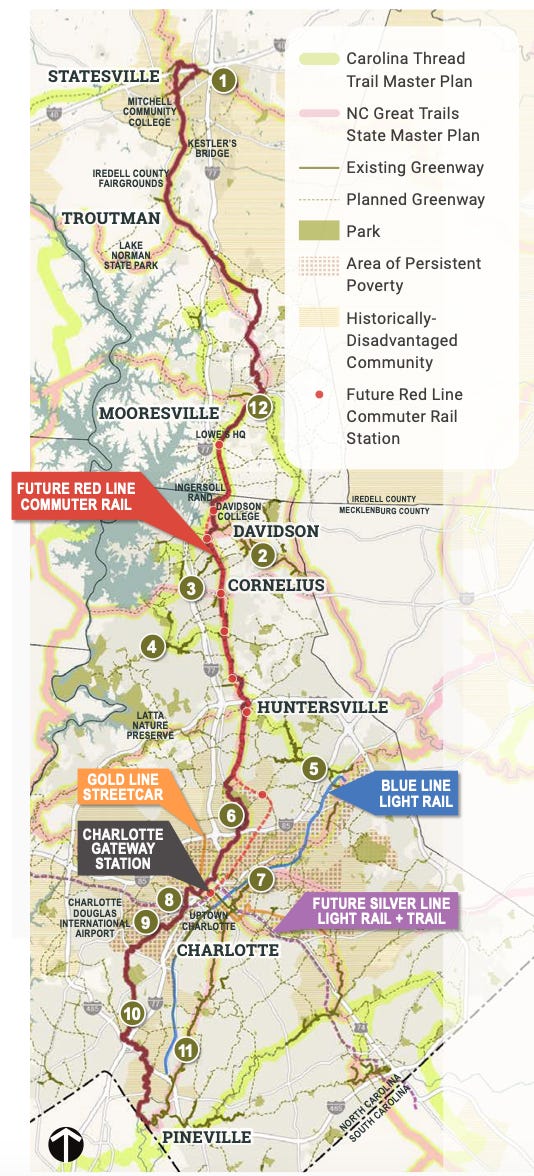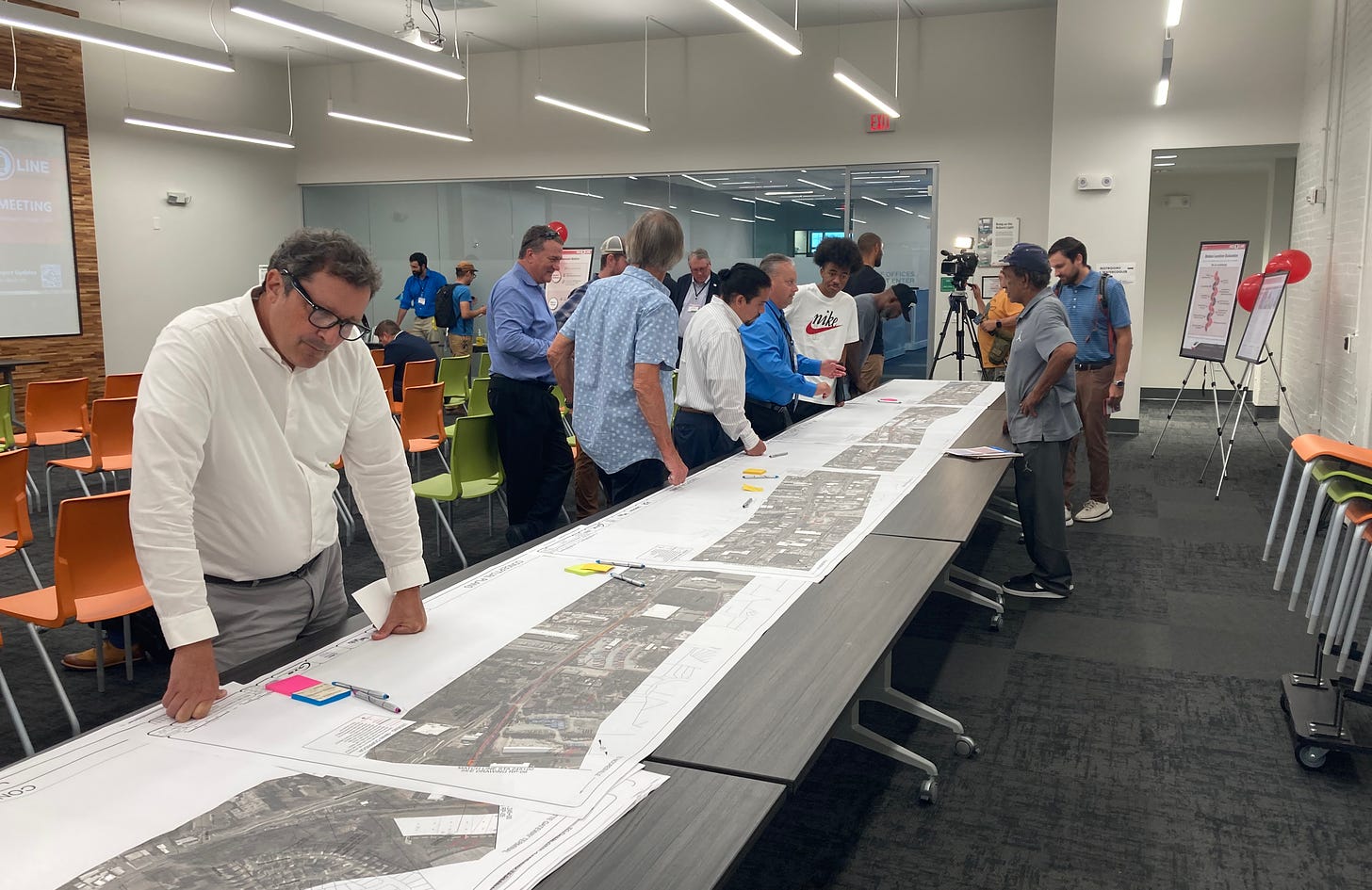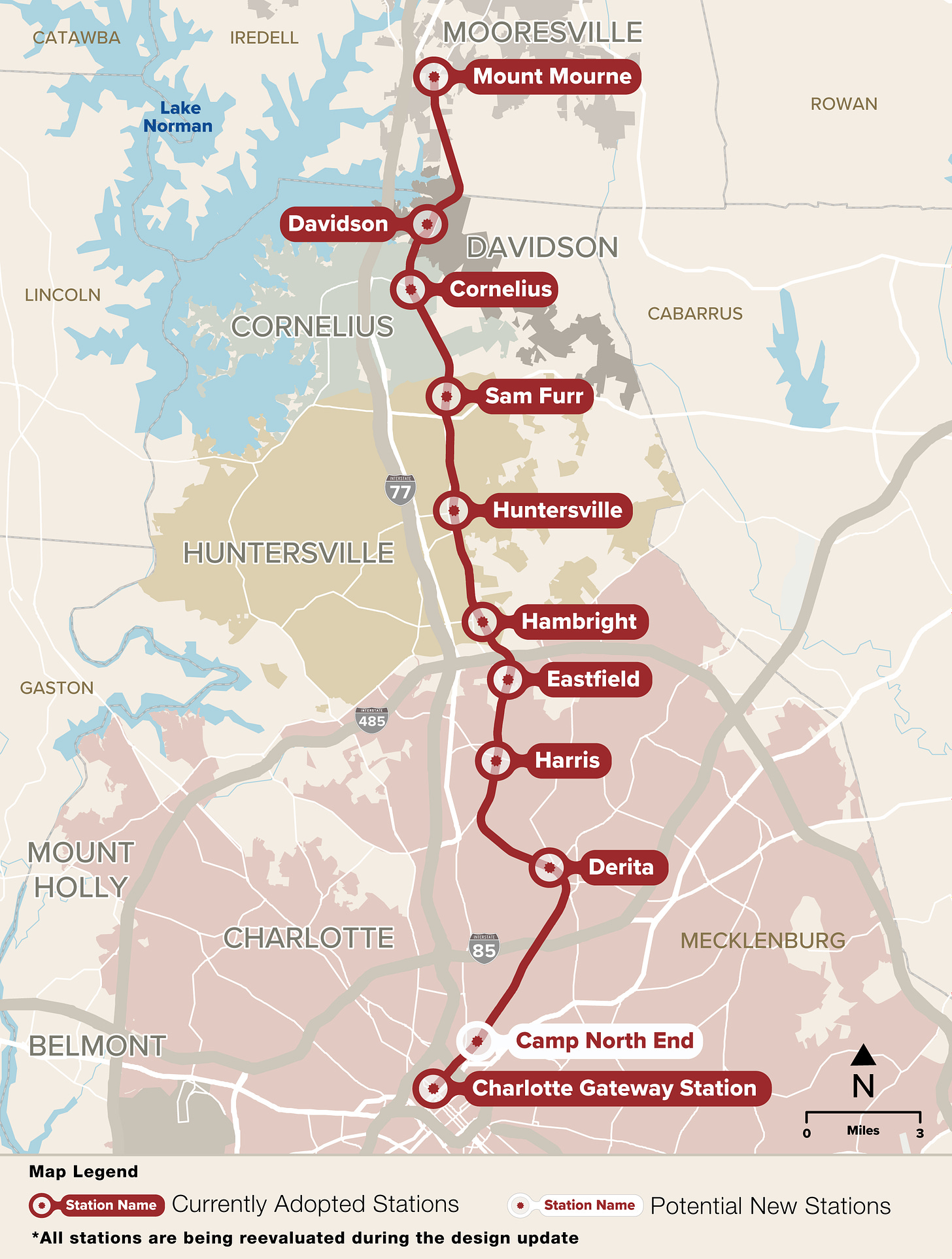Envisioning the future of the Red Line
Plus: Feud between Matthews and Charlotte over the Silver Line continues
You’re reading Transit Time, a weekly newsletter for Charlotte people who leave the house. Cars, buses, light rail, bikes, scooters … if you use it to get around the city, we write about it. Transit Time is produced in partnership between The Charlotte Ledger and WFAE.
At public meetings this week, CATS is getting into the details of the proposed rail line to north Mecklenburg; station locations, greenway, bike access
CATS employees and consultants talked with residents while examining detailed maps of the Red Line’s route and stations at a meeting this week at Camp North End.
by Tony Mecia
A few new details about the vision for the proposed Red Line to north Mecklenburg are dribbling out, as planners with the Charlotte Area Transit System started a series of public meetings this week.
CATS is quick to point out that no decisions have been made and that planners are in public-comment-gathering mode. And in any event, sketching out ideas for the Red Line remains a theoretical exercise, as passage of the funding plan (requiring legislators and voters to sign off) is far from certain.
But it’s fun to imagine, right?
Here are a few interesting pieces of information about what planners are envisioning for the Red Line, based on a talk and question-and-answer session Monday led by CATS Red Line project manager Brian Nadolny at Camp North End:
1. Some stations could be added, some could be eliminated
The original plan called for 10 stations, from uptown’s Gateway Station to Mount Mourne in Iredell County. Planners appear to be taking a serious look at adding Camp North End as a stop — so much so that it is now listed as a potential station on planning maps:
Other stations could be crossed off, as planners don’t want too many stops, which slows the ride. The proposed Hambright and Eastfield stations, which are on opposite sides of I-485, are a mere 1.5 miles apart, the shortest distance between any two stops in the original plan.
The Mount Mourne station in Iredell is also a question mark at the moment, as Iredell County wasn’t ready to commit to it when CATS was negotiating to buy the rail line from Norfolk Southern — a deal that closed last month. The contract, though, preserves the right to buy that section in the future.
2. The location of stations is likely to change (a little)
The original plans for the Red Line were devised in 2009, and since then, development has made some station locations impractical. CATS is working with neighborhood groups and developers to find ideal sites. For instance, residents in Derita have proposed placing the station near the intersection of Sugar Creek Road and Graham Street, instead of closer to Sugar Creek and Nevin Road.
CATS needs to re-examine the locations to “support current and future development potential,” Nadolny said.
3. There’s talk of a greenway
Officials in Mecklenburg and Iredell counties have started discussions on what’s being called The Seam Trail, a 60-mile walking and biking path between Pineville and Statesville. It was formerly called the Mooresville to Charlotte Trail (MCT).

A 141-page report on the trail, completed in August, says that “while The Seam is envisioned as an active transportation spine that could be implemented with or without the Red Line, opportunities for rail and active transportation integration may become available following the outcome of the Red Line study and commuter rail negotiations.” It might not go right along the tracks but be nearby, and the goal would be to integrate it to Red Line stations.
4. It will be bike-friendly
In response to a question from the audience, Nadolny said Red Line trains will support the ability to carry bikes. There will also be bike racks at stations.
5. Conductor and engineer
Ideally, when it is up and running, the Red Line will have an engineer driving the train and a conductor checking tickets — like a traditional train (and unlike the Blue Line light rail, where checking tickets is, shall we say, spotty).
6. Single track
On most stretches of the 22-mile corridor between uptown and the Iredell County line, the Red Line is envisioned as a single track.
When trains are heading opposite directions, one would pull into what’s called a “passing siding,” a stretch of track where a train could wait for a train heading the other way to pass. Or they could pass at stations, which would have tracks heading each direction. Adding a second track for the length of the line would add costs and be impractical in some areas that are tightly constrained between, say, an existing road and a building. The purchase from Norfolk Southern includes 100 feet of right-of-way, or 50 feet on each side.
7. No backup plan
Asked by a member of the audience what will become of the Red Line if the sales tax funding isn’t secured as envisioned, and if there is a Plan B, Nadolny said: “The Plan B is we will cross that when we get there.”
—
The CATS public engagement meetings continue this week and next week:
Tonight (Oct. 3), 5:30-7:30 p.m. at Cornelius Town Hall
Tuesday, Oct. 8, 5:30 p.m. virtually on CATS’ YouTube channel
Thursday, Oct. 10, 5:30-7:30 p.m. at the David B. Waymer Recreation Center in Huntersville
The first phase of the design update for the Red Line is expected to be complete in early 2025, with more details on station locations, the types of vehicles, frequencies and costs.
Tony Mecia is executive editor of The Charlotte Ledger. Reach him at tony@cltledger.com.
Related Transit Time articles:
“A Red Line reboot” (April 18)
“The basics of Charlotte’s new transit plan” (Aug. 22)
Charlotte-Matthews transit feud continues; Lyles lectures Matthews mayor about ‘transparency’ (really)
by Steve Harrison
WFAE
At last week’s Metropolitan Transit Commission meeting, Matthews Mayor John Higdon asked his colleagues for a favor.
He wanted them to tweak the allocation of money from a proposed one-cent sales tax for the county’s multi-billion dollar transportation plan. Instead of dedicating 40% of the money for roads, 40% for rail transit and 20% for buses, Higdon floated the idea of 45% for roads, 45% for rail transit and 10% for buses.
Under the current funding plan of 40-40-20, the city of Charlotte said in May that the Silver Line light rail to the town can’t be built to Matthews because there isn’t enough money.
Higdon hopes with even slightly more money for rail, at least part of the Silver Line could move forward. It might not reach Matthews, but it would be a start.
Charlotte Mayor Vi Lyles seemed taken aback by Higdon’s suggestion — made openly at a public meeting — and implied that it was a “surprise” that wasn’t mentioned to her beforehand.
She said that when local officials began discussing the transit plan they agreed that “we wouldn’t surprise each other. Maybe I’m a little surprised by this. I’m not very aware of what we are trying to accomplish. I am concerned as we are going through this process that we have real clarity for our communities. It’s tough when we have differences. … I would like our public processes for transparency reasons to be pretty consistent.”
Higdon shot back: “I was certainly surprised when I found out Matthews wasn’t going to get the Silver Line light rail in May. That was a real surprise to me.”
Lyles said that she disagreed with that assessment.
Higdon then replied: “This is a public meeting that is live streamed,” he said. “We aren’t doing anything under the cover of night.”
Watch the exchange here:
The back story: In a planning meeting this spring, Charlotte officials, Mecklenburg Manager Dena Diorio and the managers of the towns agreed to spend only 40% of any new sales tax money on trains. That was done to please Republican lawmakers in Raleigh, who told Charlotte they want a “roads-first” plan.
During those discussions in May, Matthews town manager Becky Hawke asked whether the Silver Line light rail could still be built. Charlotte said no, and said that the Silver Line would be bus rapid transit (BRT) instead. While Lyles and other Charlotte officials say they never explicitly told Matthews that, the managers of other towns have made public presentations in which they have stated the Silver Line would be BRT.
The exchange between Lyles and Higdon last week illustrates how Charlotte — and other county officials — are trying to isolate Matthews. The town is the only Mecklenburg government not on board with the transportation plan, and many of Higdon’s peers want him to stand down so the plan can move forward.
It also seems that when Lyles talks about “transparency” and not “surprising each other” she means to not rock the boat.
Ironically, the city of Charlotte is widely believed to be less than a paragon of transparency, with council members routinely negotiating and hashing out differences on major issues outside of public meetings. The Charlotte Observer reported last week that the city has more than 1,500 unfilled open records requests, many of which take months or years to provide — even though state law requires records to be “produced as promptly as possible.” The pending requests include years-old communications regarding Eastland redevelopment and deals with Tepper Sports & Entertainment. The city clerk’s office is also more than two years behind in producing written summaries of city council meetings, The Charlotte Ledger has reported.
Higdon is planning to hold a “transit summit” with elected officials later this month. He said some of his peers are blowing him off. County commissioner Leigh Altman previously said it was a “publicity stunt.”
Higdon said he’s undeterred.
“Even if it’s just me and another Matthews commissioner, I’ll hold it,” he said. “I’m not giving up.”
Steve Harrison is a reporter with WFAE, Charlotte’s NPR news source. Reach him at sharrison@wfae.com.
Transit Time is a production of The Charlotte Ledger and WFAE. You can adjust your newsletter preferences on the ‘My Account’ page.
Did somebody forward you this newsletter and you need to sign up? You can do that here:
Other affiliated Charlotte newsletters and podcasts that might interest you:
The Charlotte Ledger Business Newsletter, Ways of Life newsletter (obituaries) and Fútbol Friday (Charlotte FC), available from The Charlotte Ledger.
The Inside Politics newsletter, available from WFAE.









